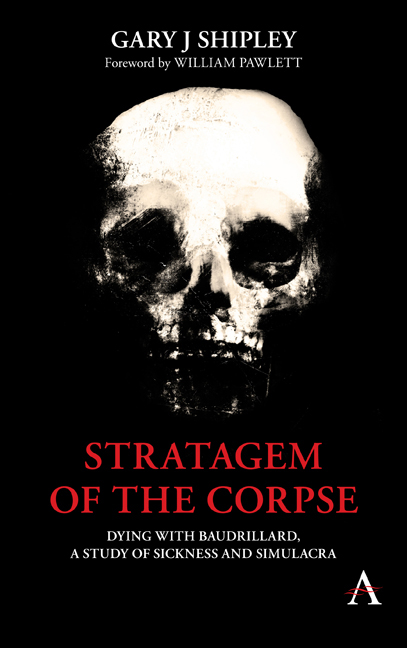Book contents
- Frontmatter
- Dedication
- Contents
- Acknowledgements
- Foreword by Pawletts William
- Introduction
- Chapter 1 On Decay and Other Synthetics
- Chapter 2 Stratagem of the Corpse
- Chapter 3 A Bleak Non-History of History
- Chapter 4 The Hyperactivity of Objects
- Chapter 5 The Unnamable Catastrophe
- Chapter 6 A Cure for Vertigo
- Chapter 7 Chance and the Temporality of Death
- Chapter 8 The Possibility of Nihilism
- Chapter 9 Smell-O-Vision: The Murder Show
- Chapter 10 The Evil Death
- Chapter 11 False Confessions and the Madness of Death: Making Death Speak
- Chapter 12 Black Light: Nigredo and Catastrophe
- Appendix 1 Whiteout: Spatiotemporal Interstices, Necropresence and the Immortality of Now
- Appendix 2 Pure Dreaming: Radicalized and Vermiculated Thought, or Death as an Earworm
- Appendix 3 The Non-Existence of the Scream
- Index
Chapter 2 - Stratagem of the Corpse
Published online by Cambridge University Press: 20 February 2020
- Frontmatter
- Dedication
- Contents
- Acknowledgements
- Foreword by Pawletts William
- Introduction
- Chapter 1 On Decay and Other Synthetics
- Chapter 2 Stratagem of the Corpse
- Chapter 3 A Bleak Non-History of History
- Chapter 4 The Hyperactivity of Objects
- Chapter 5 The Unnamable Catastrophe
- Chapter 6 A Cure for Vertigo
- Chapter 7 Chance and the Temporality of Death
- Chapter 8 The Possibility of Nihilism
- Chapter 9 Smell-O-Vision: The Murder Show
- Chapter 10 The Evil Death
- Chapter 11 False Confessions and the Madness of Death: Making Death Speak
- Chapter 12 Black Light: Nigredo and Catastrophe
- Appendix 1 Whiteout: Spatiotemporal Interstices, Necropresence and the Immortality of Now
- Appendix 2 Pure Dreaming: Radicalized and Vermiculated Thought, or Death as an Earworm
- Appendix 3 The Non-Existence of the Scream
- Index
Summary
The fake death, the simulated corpse, the staging of human remains, evokes more of the human end than the real thing. Jeremy Millar's Self Portrait of a Drowned Man represents Millar's own fictionalized death by drowning, its depicted removal from himself becoming a spectacle of its own disingenuousness, his absence an intentioned presence (both as object and creator); and yet its conflation of hyperrealism and obvious fakery is more a manifestation of what isn’t, and wasn’t, than that managed by any real drowned man. With both, I imagine lives that might have led to this: with the sculpture I know I’m playing along with an object, giving it its due, paying it the courtesy of engaging in the way that is asked of me; and in this respect I do nothing different with the actual corpse, as I engage my empathetic strategies in order that the object in front of me can justify itself. But where they differ is in the threat that is posed, because it is only the ersatz death that has already happened to me, is at this and that time happening, is constant and irremovable, whereas the real death is always elsewhere, realized in someone other than me, buried in all its unrecoverable counterpart deaths. I can pass the latter death off in opposition to my present state, and like this reaffirm life and death as not so much diachronic as synchronic. In other words, my conscious existence embraces the simulated and rejects the real. The reality of the dead man on the quayside is therefore made less real in virtue of its representing a reality to which I have no access, and it is for this reason that while the staged corpse is more of a threat, the real corpse is more viscerally impactful – at least for those of us not in the habit of seeing them. The loss of this impact in those who have for whatever reason become desensitized to seeing dead human beings, those for whom ‘the human body [exists] as an object, an anonymous thing belonging to no one, which one could dispose of in an arbitrary manner’, an aggregation of ‘indifferent brute matter’ even, allows them to acknowledge the real corpse's threat and so defend against it, as if it were its faked counterpart.
- Type
- Chapter
- Information
- Stratagem of the CorpseDying with Baudrillard, a Study of Sickness and Simulacra, pp. 21 - 32Publisher: Anthem PressPrint publication year: 2020



